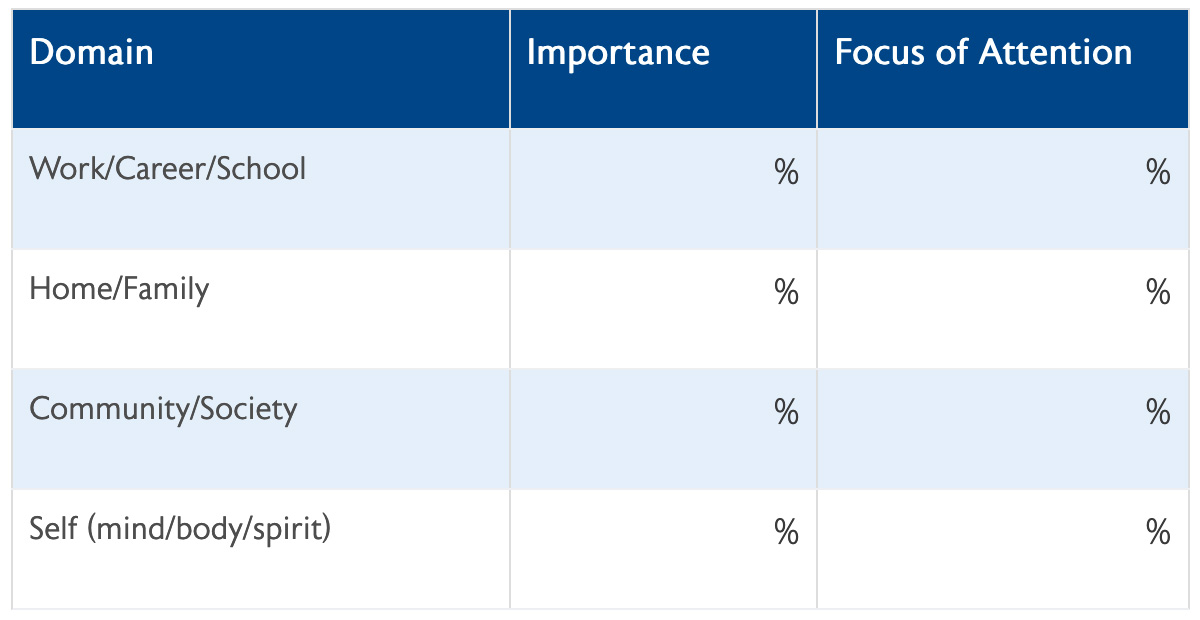Nano Tools for Leaders® — a collaboration between Wharton Executive Education and Wharton’s Center for Leadership and Change Management — are fast, effective leadership tools that you can learn and start using in less than 15 minutes, with the potential to significantly impact your success as a leader and the engagement and productivity of the people you lead.
Contributor: Stewart D. Friedman, Wharton practice professor emeritus of management; director of the Wharton Work/Life Integration Project; author of Total Leadership and co-author of Parents Who Lead (with Alyssa Westring).
The Goal:
Align your focus and attention to what really matters to you, so you can set more meaningful goals, optimize your performance, and increase satisfaction and performance in all areas of your life.
Nano Tool:
By looking closely at the different domains of your life — work, home, community, and self — you can clarify what’s important to you and see your life from a fresh perspective. Are you paying attention to what you care about most? Acting in ways that are consistent with the person you want to be? Going after goals that matter? And feeling happy with all the parts of your life, as well as life as a whole?
Completing the four-way attention chart below gives you a clear picture of how things stand today — and points out areas for change that could make life more meaningful and fulfilling. It shows how you manage the allocation of your time and energy and helps you determine whether you’re actually doing what you care about. This exercise is a crucial step forward in your thinking about experiments you might try to make things better in all parts of your life by creating more harmony among them.
This tool is designed to be customized by you, for you. So keep in mind that your subjective judgment is all that matters. For instance, your involvement in community and society is whatever this means to you, and not what others hold as important to them. It may be about giving money to charity, helping your friends, cleaning up your neighborhood, getting involved in groups working to make the world a better place, or raising children that will be good citizens.
Action Steps:
1. Define your domains. Create definitions for each part of your life that are true for you. For most people, the work domain is your job. But it could also be what you aim to do next if you’re between jobs, or it could be school if you’re currently a student. Think beyond just the hours you spend at your desk or workspace and consider the wide array of things you do as part of your career. That might include taking classes, traveling, participating in trade shows, doing research on future opportunities, or mentoring or being mentored. Home and family could include the people (or animals) you live with, your family of origin, or your family of creation (spouse, significant other, children, and others). Your community and society domain could include friends, neighbors, social groups, religious institutions, charitable activities, political committees, membership in organizations, or anything else that bears on your impact on the world beyond your work and your family. The domain of the self includes your physical and emotional health, intellectual knowledge, leisure, and spiritual life.
2. Complete the first column. Consider the relative importance of each major area of your life today. Assign a percentage to each, making sure they add up to 100%. If you place as much importance on work or school as the other three combined, put 50% in that cell on the chart. Or if all four domains are of equal importance to you, assign each 25%.
3. Complete the second column. Consider how much of your attention you actually focus on each domain in a typical week or month. Assign a percentage to each, again making sure they add up to 100%.
4. Write your responses to the following questions:
-
- What are the consequences of the current choices you make about the focus of your attention on work, at home, in the community, and for yourself?
- As you look at these eight numbers, are there any adjustments you’d like to make — either in what’s important to you or in where you focus your attention — to change any of these numbers so that your satisfaction and performance would improve?
- What would it take to actually make one of these adjustments in your life?

How Leaders Use It:
After completing the chart, one individual who manages the West Coast operations of a U.S. retail design firm said he was surprised to discover he was not “being the person [he] really wanted to be.” He was spending much less energy on community and self, and “that was not my intuition going into the exercise. I started asking… what changes could I make to pay more attention to what mattered to me — and less to what did not? What was it that I was doing at work and home that made me feel good about what was happening there?” He then looked for new ways of using what he already knew about producing satisfaction in work and home to improve his community and self areas.
An IT director at a major bank was a student in an Executive MBA program when he did the exercise. He determined that work and family were equally important to him. Personal fulfillment was less important than those domains, and community was even less so. But he was spending 65% of his energy and time on work and school and just 20% on his family. “The mismatch really bothers me,” he said. The exercise was a wake-up call, clarifying what is important and creating new insights into positive changes.
Additional Resources:
- Total Leadership: Be a Better Leader, Have a Richer Life, by Stewart D. Friedman
- Wharton Executive Education: Women’s Executive Leadership: Business Strategies for Success
- Wharton Executive Education: The Adaptable Leader: Leading in a Virtual World
- Access all Wharton Executive Education Nano Tools
- Download this Nano Tool as a PDF



